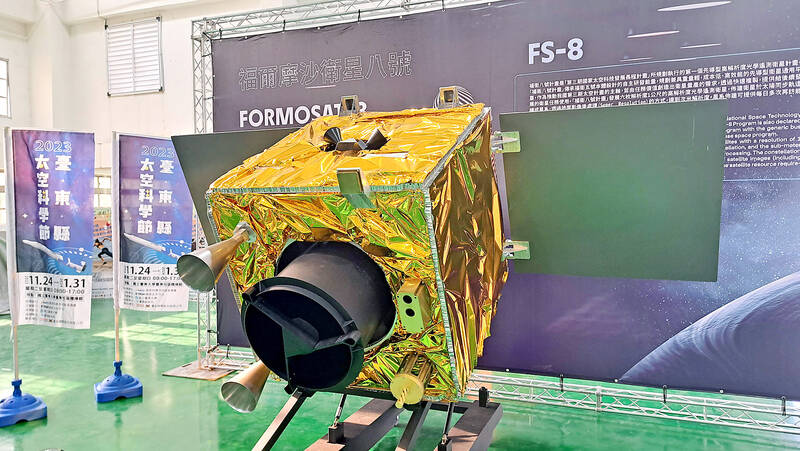The Formosat-8 satellite program would be equipped with eight Taiwan-made high-resolution optical remote sensing satellites and an artificial intelligence (AI) system, with one satellite launched annually over the next seven years, the Taiwan Space Agency (TASA) said.
In its draft of the third phase of the national space technology development project, which was submitted to the Executive Yuan at the end of last month, the National Science and Technology Council proposed to extend the project’s expiration date from 2028 to 2031, with the funding for the project expanding to NT$40 billion (US$1.2 billion).
The main tasks of the project would be to develop high-resolution optical remote sensing satellites and low Earth orbit satellites. The Formosat-8 is a pilot project for high-resolution optical remote sensing satellites, which would also be the nation’s first satellite equipped with an AI system.

Photo: Huang Ming-tang, Taipei Times
Based on TASA’s plan, Formosat-8, like Formosat-5, would be a light, low-cost, but highly efficient satellite platform designed and developed by Taiwanese engineers. Formosat-8 project manager Cynthia Liu (劉小菁) said the project would build a total of eight remote sensing satellites, with six of them having the ability to capture high-resolution images of objects 1m above ground from an altitude of about 561km.
“Post-processing” of the satellite images would show those of items 0.7m above ground, Liu said, adding that the resolution of the last two satellites would allow them to capture images under 1m above ground, she said.
The first remote sensing satellite — FS-8A — has completed a thermal vacuum test, Liu said, adding that it is scheduled to be launched into space in the fourth quarter of this year on a SpaceX rocket.
One satellite would be launched annually over the next seven years, she said.
The National Atomic Research Institute has also been researching the development of domestically produced solar cells, which are scheduled to be launched into space along with a second remote-sensing satellite in 2027.
If the solar cells are certified, the percentage of the satellite components made in Taiwan would be increased, Liu said.
“As countries around the world step up competition in the space age, solar panels that could be used in space are expected to be in high demand, she said.
“If we have the technology, we can develop the space industry further, and more countries would place orders for Taiwan-made solar cells,” she added.

Three Taiwanese airlines have prohibited passengers from packing Bluetooth earbuds and their charger cases in checked luggage. EVA Air and Uni Air said that Bluetooth earbuds and charger cases are categorized as portable electronic devices, which should be switched off if they are placed in checked luggage based on international aviation safety regulations. They must not be in standby or sleep mode. However, as charging would continue when earbuds are placed in the charger cases, which would contravene international aviation regulations, their cases must be carried as hand luggage, they said. Tigerair Taiwan said that earbud charger cases are equipped

UNILATERAL MOVES: Officials have raised concerns that Beijing could try to exert economic control over Kinmen in a key development plan next year The Civil Aviation Administration (CAA) yesterday said that China has so far failed to provide any information about a new airport expected to open next year that is less than 10km from a Taiwanese airport, raising flight safety concerns. Xiamen Xiangan International Airport is only about 3km at its closest point from the islands in Kinmen County — the scene of on-off fighting during the Cold War — and construction work can be seen and heard clearly from the Taiwan side. In a written statement sent to Reuters, the CAA said that airports close to each other need detailed advanced

Tropical Storm Fung-Wong would likely strengthen into a typhoon later today as it continues moving westward across the Pacific before heading in Taiwan’s direction next week, the Central Weather Administration (CWA) said. As of 8am, Fung-Wong was about 2,190km east-southeast of Cape Oluanpi (鵝鑾鼻), Taiwan’s southernmost point, moving westward at 25kph and possibly accelerating to 31kph, CWA data showed. The tropical storm is currently over waters east of the Philippines and still far from Taiwan, CWA forecaster Tseng Chao-cheng (曾昭誠) said, adding that it could likely strengthen into a typhoon later in the day. It is forecast to reach the South China Sea

WEATHER Typhoon forming: CWA A tropical depression is expected to form into a typhoon as early as today, the Central Weather Administration (CWA) said yesterday, adding that the storm’s path remains uncertain. Before the weekend, it would move toward the Philippines, the agency said. Some time around Monday next week, it might reach a turning point, either veering north toward waters east of Taiwan or continuing westward across the Philippines, the CWA said. Meanwhile, the eye of Typhoon Kalmaegi was 1,310km south-southeast of Oluanpi (鵝鑾鼻), Taiwan’s southernmost point, as of 2am yesterday, it said. The storm is forecast to move through central